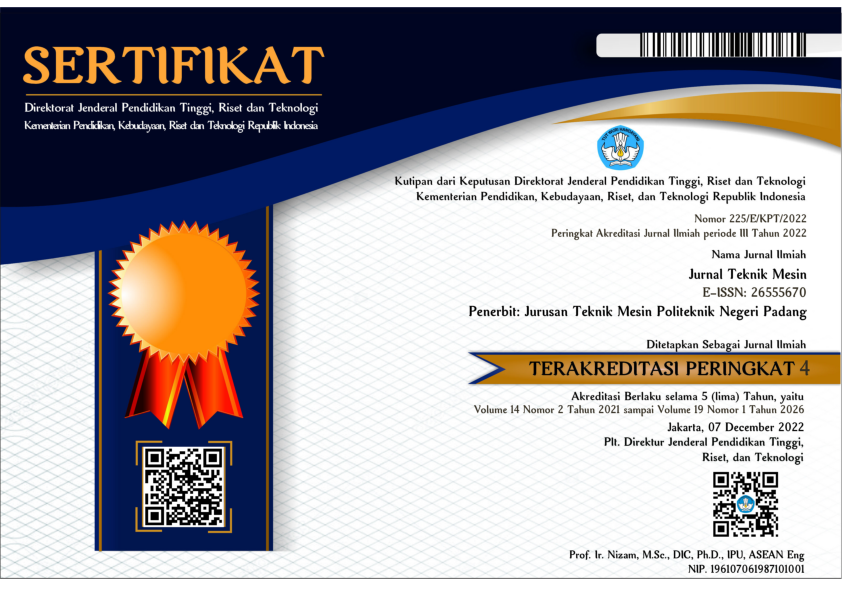STUDY OF SURFACE FINISH OF STEREOLITHOGRAPHY (SLA™) PRODUCTS
Abstract
Recently, development of Rapid Prototyping technique refers to Rapid Tooling (RT) application. Unfortunately, considering the limitation of technology available and suitable material, the research activities are respectively stagnating on improvement the method using building tool with recent technology and material. However, the problem being faced by researchers are not only limitation pre-mentioned above but also due to difficulties to gain tool with high part qualities. Therefore, in this present research, the part qualities especially surface finish would become primary consideration. Moreover, the obstacles in gaining the part with high surface finish on RP technology is the staircase effect, which is influenced by orientation angle. So, to reach the aim of research in observing the orientation angle for which part would have good surface finish, the orientation angle will be varied. The result shows that surface roughness of SLA built on 0 and 11,25 considerably have good impact on surface finish of the part building directly from Rapid Prototyping machine.
References
2. Brooker, K., ed., 1984. Manual of British Standards in Engineering Metrology, London. British Standard Institution in association with Hutchinson
3. Chatfield, Ch., 1983,Statistics for technology: A course in applied statistics. London. Chapmanand Hall
4. Diamant, B.2001a. Rapid Prototyping [Online]. Available from: http://www.bath.ac.uk/~en7bnd/rp/3d.htm [A ccessed: 10 July 2001]
5. Diamant, B.2001b. Rapid Prototyping [Online].Available from: http://www.bath.ac.uk/~en7bnd/rp/intro.htm [Accessed: 10 July2001]
6. Dong, J., 1998.Introduction to rapid response manufacturing. In: J.Dong eds. Rapid Response manufacturing: Contemporary methodologies, tools and technologies. London. Chapman and Hall, 1998, 1-7
7. Fadel, G.M and C. Kirschman., 1996. Accuracy issues in CAD to RP translation. Rapid Prototyping Journal, 2(2), 4-17
8. Grenda, E.P. 1999. The Worldwide Guide to Rapid Prototyping: what is rapid prototyping a briefly tutorial) [Online]. Available from: http://home.att.net/~castleisland/rp_int1.htm and http://home.att.net/~castleisland/3dp.htm [Accessed: 8 May 2001]
9. Hope, R.L. et al., 1997.Adaptive slicing with sloping layer surfaces. Rapid Prototyping Journal, 3(3), 89-98.
10. Mulyadi, I.H,2001. Comparison Experimental Investigation of Surface Roughness and Dimensional Accuracy of Two Rapid Prototyping Techniques. dissertation. Portsmouth. University of Portsmouth
11. Karapatis, N.P. et al., 1998.Direct rapid tooling: A review of current research. Rapid Prototyping Journal, 4(2), 77-89.
12. Kochan, D. et. al, 1999.Rapid prototyping issues in 21st century. Computers in Industry, 39(1999), 3-10.
13. Kulkarni, P. and D. Dutta, 1996.An accurate slicing procedure for layered manufacturing. Computer-Aided Design, 28(9), 683-697.
14. Lakkis, I.1996. Accuracy and surface finish [Online]. Available from: http://www.aub.edu.lb/ alumni/ssc/proto5.htm. [Accessed: 7 May 2000]
15. Lamancusa, J.S. 2000. Rapid prototyping primer: what is Rapid Prototyping [Online]. Available from:
16. http://www.me.psu.edu/lamancusa/rapidpro/prim er/chapter2.htm. [Accessed: 9 May 2001]
17. Lan, P.T, 1997.Determining fabrication orientations for rapid prototyping with stereolithography apparatus. Computer-Aided Design, 29(1), 53-62.
18. Lee, K.H. and K. Choi, 2000.Generating optimal slice data for layered manufacturing. International Journal of Machine Tool and Manufacture, 16: 277-284.
19. Lin, F.et al., 2001.Optimization with minimum process error for layered manufacturing fabrication. Rapid Prototyping Journal, 7(2), 73-81.
20. Ma, W. and P. He, 1999.An adaptive slicing and selective hatching strategy for layered manufacturing. Journal of Materials Processing Technology, 89-90(1999), 191-197.
21. Majhi, J. et al. (). Multi-criteria geometic optimisation problem in layered manufacturing. Available from: http://www.
22. Pham, D.T. and R.S. Gault, 1998.A comparison of rapid prototyping technologies. International Journal of Machine Tool and Manufacture, 38(1998), 1257-1287.
23. Root, K.Y., What is Rapid Prototyping: a beginner’s guide to Rapid Prototyping [Online]. Available from: http://www.eng.uah.edu/~rootk/ Engineering/RP2.htm#geo [Accessed : 9 May2001]
24. Rosochowski A. and A. Matuszak, 2000.Rapid tooling : The state of art. Journal of Materials Processing Technology, 106(2000), 191-198.
25. Shellabear, M. 1998. Model Manufacturing processes-state of the art in rapid prototyping (First report of literature research. Feb.1998). Available from:http://129.69.86.144/raptec/Reports/deliverables/Deli2_t42_all.PDF. [Accessed: 12 July 2001]
26. Wah, W.H. 1999. Limitation of Rapid Prototypes. Available from: http://rpdrc.ic.plyu.edu.hk/content/rp_prototypes_limitation.htm. [Accessed: 9 May 2001]













